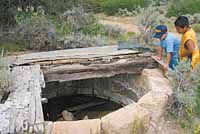| Stanley and Moon Canales peer into an old well in an area of Consumers Canyon where coal camps existed years ago. Mosquitoes can breed in areas with standing water, enabling West Nile virus to thrive. |
Late last summer, Carbon County was one of the first places that West Nile was detected in Utah.
To date in 2004, the virus has not shown up in mosquitoes or test birds in the local area, but that situation does not hold true for the rest of the state.
Utah public health officials report that West Nile virus has been detected in mosquitoes in Grand and Washington counties.
Additionally, two residents, one from Box Elder and one from Salt Lake County, have been diagnosed with the disease.
Local abatement districts have been trapping mosquitoes for West Nile virus detection since May. Last week, West Nile was detected in one batch of mosquitoes from Grand County and two batches from Washington County. The incidents mark the first detections of West Nile in Utah in 2004.
The detection of the virus in mosquitoes is not surprising, according to public health officials. There has been significant West Nile activity in the Grand Junction area of Colorado, as well as in Arizona and Nevada.
“We have been expecting West Nile to come and we are fortunate that it has not appeared in Utah until now,” noted David Cunningham of Southeastern Utah Health District. “It is important for the community to be aware that West Nile is in the state. Individuals should also understand what measures they can take to protect themselves from getting the disease.”
The protective measures include wearing mosquito repellant that contains DEET as well as long-sleeved shirts and pants whenever possible while outdoors from dusk to dawn.
The Box Elder resident, who is between the age of 45 and 64, is the first Utahn reported with West Nile virus in 2004, indicated public health officials. During the incubation period for the disease, the invididual reportedly traveled to Arizona.
Public health officials cannot determine whether the person was infected during travel to Arizona or while in Utah.
The public health system also received a report last Thursday about the Salt Lake County resident who appears to have been infected with the virus. An investigation is being conducted to learn about the possible exposure and where it occurred..
In 2003, West Nile virus was detected in mosquitoes, horses, chickens, birds, and two human in eight Utah counties including Carbon, Duchesne, Emery, Grand, Sanpete, Uintah, Utah, and Wayne. West Nile is transmitted to both humans and horses by mosquitoes. WNV is not transmitted from person to person.
Most people who are infected with West Nile virus do not show any symptoms.
About one in five have flu-like symptoms with fever, muscle aches and possibly a rash.
About one in 150 develop a more severe illness affecting the brain and spinal cord. Patients who develop the more severe illness may have symptoms such as headache, paralysis and stiff neck.
The risk of severe illness increases with age. But there is no age at which there is no risk of illness.
As of July 27, the U.S. Centers for Disease Control and Prevention reported 256 cases of the virus in the nation, with six deaths. Arizona has the highest number of cases at 161.
The state departments of health and agriculture-food along with local mosquito abatement districts and the Utah Division of Wildlife Resources are collaborating in tracking and monitoring West Nile virus.
In affected areas, local mosquito abatement district workers are increasing efforts to reduce the number of mosquitoes that can spread the disease.
For additional information about West Nile virus, Carbon County residents may call the Southeastern Utah Health District at 637-3671.

